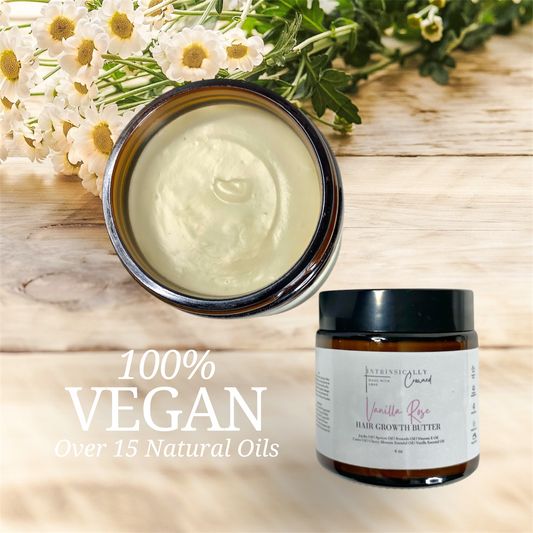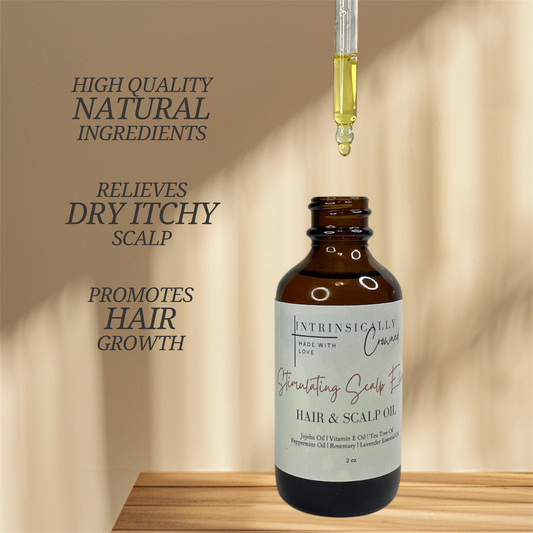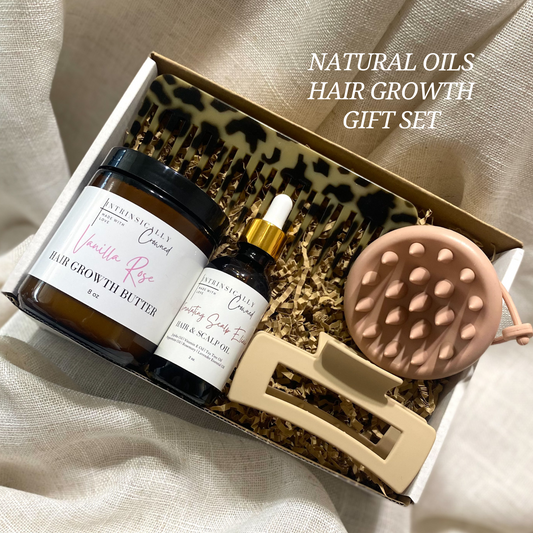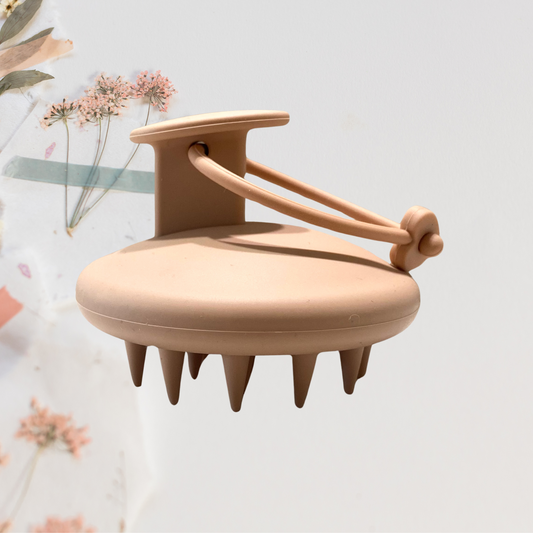
Best Practices for Caring for 4b/4c Hair Types
Share
Okay Queens, do you know what your hair type is? I think it’s important to know, to help you understand the best way to care for your crown. I’m 4b/4c, and boy it can be a challenge, but I love my crown. It’s what God gave me and if he gave it to me, I know it’s the best for me.
4b/4c hair is a unique hair type that requires special care and attention. This hair type is known for its tight curls and coils, which can make it difficult to manage. One of the unique characteristics of type 4 hair is shrinkage. While some people may see shrinkage as a negative aspect of this hair type, it is actually a good thing. Shrinkage is a sign of healthy hair and shows that the hair is able to retain moisture.
However, 4b/4c hair is also very fragile and can easily become damaged if not cared for properly. This hair type is prone to breakage and split ends, which can make it difficult to grow long, healthy hair. It's important to keep 4b/4c hair stretched to prevent tangling and breakage. This can be achieved through protective styling and avoiding styles that pull on the hair too tightly.
When it comes to washing 4b/4c hair, it's best to keep it to a minimum. Overwashing can strip the hair of its natural oils and cause it to become dry and brittle. Experts recommend washing 4b/4c hair no more than once a week and using a sulfate-free shampoo to avoid further damage. To tell you the truth, I wash my crown about once a month. That’s what works for me. Deep conditioning treatments should also be used regularly to keep the hair moisturized and healthy.
Understanding 4b/4c Hair Type
What is 4C Hair Type?
4c hair type is characterized by tight, densely packed curls that form a zigzag pattern. This hair type is fragile and prone to breakage, which is why it requires special care and attention. 4c hair is the most delicate and sensitive hair type, and it requires a lot of moisture to stay healthy and strong.
One of the defining features of 4c hair is its tendency to shrink. While some people may view shrinkage as a negative aspect of 4c hair, it actually serves a beneficial purpose. Shrinkage is a sign of healthy hair, as it indicates that the hair is retaining moisture and elasticity. When 4c hair is stretched, it can become dry and brittle, which can lead to breakage and damage.
Why is 4b/4c Hair Type Fragile?
4b/4c hair is fragile for several reasons. Firstly, the tight curls of 4b/4c hair make it difficult for natural oils to travel down the hair shaft, which can lead to dryness and breakage. Additionally, 4b/4c hair is prone to tangling and matting, which can cause hair to break when combed or brushed. I NEVER comb or detangle my crown when it’s dry. I always use a moisturizer and water when I’m detangling.
Another reason why 4b/4c hair is fragile is because of its structure. The zigzag pattern of 4b/4c hair makes it more susceptible to damage from heat styling, chemical treatments, and harsh products. 4b/4c hair also has a high density, which means that it has more hair strands per square inch than other hair types. This can make it difficult to detangle and style, which can lead to breakage and damage.
Given the fragility of 4b/4c hair, it is important to take special care when washing and styling it. It is best to keep 4b/4c hair stretched, as this can help to prevent tangling and matting. Additionally, it is important to use gentle, moisturizing products that are specifically designed for 4b/4c hair.
Why Shrinkage is Good for Type 4 Hair
Benefits of Shrinkage
Shrinkage is a natural characteristic of the 4b/4c hair type, and it is actually a sign of healthy hair. When 4b/4c hair shrinks, it means that the hair is full of elasticity and has the ability to bounce back to its natural state. This elasticity helps to prevent breakage and damage to the hair, which is essential for maintaining healthy hair.
Another benefit of shrinkage is that it helps to protect the ends of the hair. When the hair is stretched, the ends of the hair are more exposed and prone to damage. However, when the hair is allowed to shrink, the ends of the hair are protected and less likely to become damaged.
How to Keep Type 4 Hair Stretched
For those with type 4 hair, stretching is an essential part of the hair care routine. Keeping the hair stretched helps to minimize shrinkage and breakage, making it easier to manage and style.
Stretching Techniques
One of the best ways to stretch 4b/4c hair is by sectioning and twisting the hair while washing. This technique helps to prevent acute shrinkage during wash days. When preparing the hair for a wash, take large sections and twist the hair. After applying shampoo, conditioner, and rinsing, take out one twist at a time.
Another popular stretching technique for 4C hair is the banding method. I use these Satin Scrunchies to stretch my crown. Simply divide the hair into sections and wrap the satin scrunchies around each section. Leave the hair to dry before removing the satin scrunchies to reveal stretched hair.
Protective Styles
Protective styles are another great way to keep 4b/4c hair stretched. Styles such as braids, two-strand twists, and bantu knots help to elongate the hair and reduce shrinkage. These styles also protect the hair from damage and breakage, allowing it to grow longer and healthier.
Tools for Stretching
There are several tools that can be used to stretch type 4 hair. One of the most popular tools is a blow dryer with a diffuser attachment. The diffuser helps to distribute heat evenly, reducing the risk of heat damage while stretching the hair. Another tool that can be used is a hair steamer. The steam helps to soften the hair, making it easier to stretch. I rarely put heat on my crown.
It is important to note that type 4 hair is fragile and can easily become damaged if not properly cared for. It is recommended to wash 4b/4c hair every two to four weeks with a non-sulfate shampoo to avoid buildup and odors. A pH-balanced moisturizing shampoo and conditioner will clean the hair and scalp while promoting softer textures and increased growth. Between washes, if the hair lacks moisture, co-washing can be done to keep the hair moisturized.
How Often to Wash 4C Hair Type
Washing type 4 hair is a delicate process that requires careful attention to detail. Factors such as hair texture, scalp condition, and lifestyle all play a role in determining how often to wash type 4 hair. Listen to your crown. She will tell you when she needs to be washed.
Factors to Consider
One of the biggest factors to consider when determining how often to wash 4b/4c hair type is the hair's natural oil production. Type 4 hair has low porosity, which means that the strands are tightly packed together and can make it difficult for oil to penetrate the hair shaft. This can cause the hair to become dry and brittle, which can lead to breakage.
Another factor to consider is the individual's lifestyle. People who exercise or engage in physical activities that cause sweating may need to wash their hair more frequently to prevent buildup and odor. Additionally, people who live in areas with high levels of pollution or have allergies may need to wash their hair more frequently to remove irritants from their scalp and hair.
Tips for Washing Type 4 Hair
When washing type 4 hair, it's important to use a gentle shampoo that won't strip the hair of its natural oils. Sulfate-free shampoos are a great option for 4b/4c hair types because they are less harsh and won't cause excessive dryness.
It's also important to avoid using hot water when washing 4b/4c hair type. Hot water can cause the hair to become dry and brittle, which can lead to breakage. Instead, use lukewarm or cool water to wash the hair.
After washing, it's important to deep condition the hair to restore moisture and prevent breakage. Leave-in conditioners and hair masks are great options for 4b/4c hair types because they provide long-lasting moisture and can help to detangle the hair. Our Vanilla Rose Hair Growth Butter helps lock in moisture as well and nourish your strands.
That’s it, Queens! The most important thing to remember is to listen to your crown. She will tell you exactly what she likes and dislikes. And remember… be patient. It takes time to grow your crown, so don’t give up.
With love,
Dana





